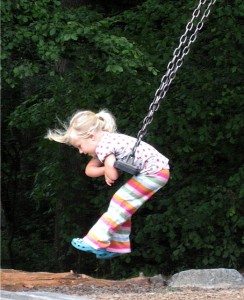I wrote this article for the 6th National conference of the United States Association for Body Psychotherapy, held October, 2010. The theme of the conference was “Unraveling Trauma: Body, Mind and Science.” My presentation was to relate to the theme.
Somatic Awareness/Sensory Awareness
– A Path of Unraveling Trauma
Abstract: The author presents Sensory Awareness as a valuable manner of working with traumas and an essential part of unraveling trauma. She presents examples of working within a traditional therapeutic situation and mentions its use in other venues. Case histories and other examples are submitted.
— — — — —
 The theme of “unraveling trauma” is a very important choice of words to describe the way we must work with trauma. Traumas are often a bundle of experiences that have been traumatic, at different levels of intensity. Often a similar trauma is recapitulated in many different ways at different times of one’s life. And often that bundle of trauma can start very early – at birth or even before. A practitioner may work with a client on a trauma issue and feel that it has been resolved only to find it reemerging through another aspect. If the practitioner does not work clearly with the various pieces and the core of the trauma, there is also the possibility of retraumatizing or strengthening the reaction to or defense around the trauma. That is why I feel it is so important to “unravel” these deep issues as the work proceeds. I find the simple work of Sensory Awareness indispensable in locating, clarifying, and working with the traumatic issue(s).
The theme of “unraveling trauma” is a very important choice of words to describe the way we must work with trauma. Traumas are often a bundle of experiences that have been traumatic, at different levels of intensity. Often a similar trauma is recapitulated in many different ways at different times of one’s life. And often that bundle of trauma can start very early – at birth or even before. A practitioner may work with a client on a trauma issue and feel that it has been resolved only to find it reemerging through another aspect. If the practitioner does not work clearly with the various pieces and the core of the trauma, there is also the possibility of retraumatizing or strengthening the reaction to or defense around the trauma. That is why I feel it is so important to “unravel” these deep issues as the work proceeds. I find the simple work of Sensory Awareness indispensable in locating, clarifying, and working with the traumatic issue(s).
In addition to the presentation of specific traumas, people also present the entanglement of various other kinds of complaints: chronic pains and chronic illnesses, psychosomatic or actual physical diseases, even “just” muscle tension, movement limitations, etc. All of these could be expressions from traumatic experiences. How can we know that, and if so, where do we start?
Where I start is to attempt to understand the situation in a basic way: by helping the person experience what is happening to her/him through simple sensations. I find sensations are the key to understanding what were/are the basic reactions to the traumatic situation. In not focusing on the multitude of emotions that generally arise, we can avoid the entanglement of confusion, projections, and protections which arise when we are trying to take care of ourselves, and the disappointments and feelings of failure that arose when we were not able to protect ourselves sufficiently.
Sensations provide an important key and information about how we responded to the pertinent traumatic experience and they also inform us about how we are still currently responding. Through sensations we may be able to connect to a physical reaction – a movement, a subtle muscle response, a small impulse – and through this we can begin to unravel our past and present responses.
Paying attention to the sensations assists both parties in the therapeutic situation. It allows the client to concentrate on the reality of what is happening to him/her in the moment, uncomplicated by the more emotional aspects of the event. And it helps inform and direct the practitioner to work with the micro-movements or subtle reactions that are so important to respond to and work with.
Without this “sensation map” it might take us much longer to recognize the minute actions/reactions that are crucial clues in the work. Acknowledging them and bringing them to the forefront of the current therapeutic situation offers the client a somatic way to recognize what is still happening for him/her and a viable means of working with the trauma, in a way that was not previously available. For instance by focusing on the micro-movement and increasing it, or bringing it into sound or movement, or exaggerating it and responding to it, we can work with the traumatic situation and empower the client with information to which s/he can respond. S/he can react to a situation in the somatic present whereas in the past s/he might have felt impotent. Currently those impulses are still buried and yearning for expression.
If we stay away from the interpretations and projections, the sensations that are being experienced can tell us a lot about how we related to the trauma in the past. Trauma that has happened in the past cannot be changed. All we can change are our present reactions – defense, resistance, sublimation, etc. – that we are experiencing at this moment. All of these responses have a sensory component and many have some movement and/or physical aspect. The more we can experience and understand them, the more readily we can deal with our reactions.
I am not suggesting that we ignore our emotions or that we not allow our feelings to arise around these incidents. But I am suggesting that the sensory awareness can give us a clearer foundation with which to understand and work with them. As we realize our sensations, we can better understand our emotions. As we realize and untangle our reactions (somatic, physical and emotional) of the present, we may then be able to go back and unravel our current reactions to something in the past, and then proceed further in the past to the brunt of the trauma.
Awareness is the crucial, fundamental element. Without awareness we will continue to repeat, respond, resist, and not really understand the source of the reactions. With awareness of the sensation and the reaction to it we can have the opportunity to understand and change something if we want. If we decide we do not want to change, then we are empowered by that knowledge and decision.
In this paper I will give several examples of how I use Sensory Awareness, which I prefer to call Somatic Awareness, to direct me to the foundation of the trauma(s), how I use sensing to arrive at the clarification of what the client needs to work on, and how this sensory and somatic awareness is a major part of unraveling trauma.
Case History:
An elderly woman was referred to me by her meditation instructor. She had an unusual cough that had persevered for years. Medical investigation showed no cause. She was very experienced in psychological searching. She had worked deeply in various therapeutic modalities such as depth analysis, sand tray, etc. She also used revealing writing therapeutic techniques as well as other modalities and meditations. It was sort of on a fluke that she came to me. She had already done so much and knew so much. I was, one might say, her last resort. The only way I could imagine working with her was through Sensory Awareness. The sensing work quickly exposed areas of her experiences, both physical and emotional, that were still completely closed off. She had no interest in opening them. She was curious, however, and became interested in following her senses in various parts of her body. As she became more acquainted with her realm of senses, she felt safe enough to come closer to the areas in herself that had not been available previously. The support she was receiving from the sensory awarenesses gave her the ability to allow other sensations – and memories – to appear. This work uncovered a massive history of ritual and sexual abuse that she had never suspected. She could barely believe it. She did not want to believe it. In fact she admitted that, “I don’t want to believe this ever happened, but I can feel this in my body so I have to believe it.” Our working through her senses gave her the strength to believe it and to understand and heal deep, old issues. These discoveries gave her many answers about how her prior investigations and therapies had missed these crucial issues. “Too many other techniques were covering them up”, she said. With specific sensing and healing the areas of her distresses, her cough eventually subsided.
Case History:
Sally came to me after having seen another therapist who had told her she was in grave trouble and needed a lot of therapy. Sally was scared and frustrated by what the other therapist had told her. She didn’t understand it and didn’t know what to do. As we initially talked and I took her history, I kept stopping and asking her what her sensations were. It may have been frustrating for her to be interrupted so much, but by the end of the first session Sally had an idea of what her predicament was and how she reacted to what was happening in her life. As she connected to some of her sensations, she felt that she could get a handle on how she could proceed and how we could work. Rather than just allowing her to run on with all her problems, my stopping her and asking her to sense what she was experiencing – not her emotions; but her sensations – helped her stay more in touch with herself. This untangling of physical and emotional sensations provided a sense of understanding and a feeling that she really could be in charge; that no one was going to take away her integral sense of herself. She finally felt that she could stay in touch with those feelings and begin to do the work that needed to be done.
Working with Infants and Children:
Working with infants is at the same time difficult because they cannot tell you what is happening to them or describe their pain; and easier because they have not yet developed many sublimations and rationalizations. I admit that I don’t need to lead them into sensing explorations because they are already constantly engaged in their own sensory experiences. I use my experience of my own sensing to relate to what I sense in them and let them lead me where they need to go to repattern their traumatic experiences. It is invaluable for me to have Sensory Awareness skills to track the infant, but most importantly I also track myself. I also find it very important to help the parents learn to track their own sensations too. It is easy for parents to become overwhelmed with emotions around traumatic issues with their children; and it is also very easy for the children’s issues to be entangled with the parent’s own unresolved traumas. Since we are essentially working nonverbally with infants, it is even more crucial to have these Sensory Awareness skills available and to be able to pass them on to the caretakers. How wonderful and important it is when we can work early with unraveling the early traumas!
Quite frankly, my preference is to work with a future mother prior to the birth (or even better, conception) of her child. Working with the father too is very helpful and makes an immense difference in how the child is received, and how family dynamics develop. It can even affect patterns of discipline as the child grows. Any recognition and resolution of traumas in the parents’ lives can be instrumental in avoiding traumas in the new birthing and incipient family situation.
When I work with infants and children, I always want the parents present. If none of their own work in this area has been done prior to this time, the adult(s) may begin to recognize some of their own needs which we need to also accommodate while working with the child.
Working with Adults on Prenatal and/or Perinatal Traumas:
As mentioned above, it is ideal when adults who plan to have children are able to work to understand and perhaps resolve their own birth or prenatal traumas. Most of us don’t consider how much our traumas have affected our own lives and inform how we give birth and raise our children.
The prenatal and perinatal trauma resolution work I have done both individually and in small group situations can make a huge difference in adult lives. Whether or not one has or intends to have a child, resolving the early traumatic incidences is enlightening. For instance, the adult whose birth was induced may find a connection to his/her resistance to get things done on time.
Just sensing through a rushed (possibly medicated) birth and then allowing it to be sensorily repatterned at the desired pace can untangle many unpleasant connections and bring understanding and resolutions to one’s life.
Medication, caesarian sections, twin loss experiences -each of these and more can create complicated entanglements that would be very difficult to understand any way other than somatically, especially because all these incidents happened long before verbality. They can easily be confused and taken for other traumas and Sensory Awareness is the way to understand the language.
Being able to sensorily experience and therefore understand more clearly what happened to cause the fear, the phobia, the confusion and the unease can change and enhance one’s life at any time.
Working with Other Traumas:
People who have fought and been tortured in wars have bundles of various traumas, both from fighting offensively, defending themselves, and perhaps being captured and imprisoned. An essential part of their healing is to help them untangle the traumas of the past by finding their way to their current sensory experiences, and then be able to differentiate between past and present. In this way they can proceed to accept themselves in the present.
One of the first survivors of a prisoner camp that I worked with was very resistant. He said, “You cannot know. You don’t want to know.” I knew he was right. We both knew we could do nothing about what had happened to him. But through Sensory Awareness I was able to help him recognize sensations that he could experience in the present. These he could appreciate and they could allow him some space for easier living.
The Holocaust survivor who had been a hidden child during the war had bundles of entanglement of traumas. Through Sensory Awareness we worked on uncovering the sensations that had been so deeply buried for so long. Eventually she was able to find and hear her voice so that she could understand what she had gone through and how she had had to respond, and that now she didn’t need to continue in that manner. After we were able to untangle some of the traumatic experiences we were also able to use sensing to work with centering and grounding so that she could relax, stop injuring herself so much, and eventually realize that she was really, finally, safe. Breath was a very important aspect here. The process of finding her breath-learning to allow her breath, learning that she did not have to control it, that it could speak for her and be resourceful and supportive-was a huge assist in changing her life.
When I worked with the Tibetan Buddhist Nuns in exile in India, I was grateful that I could help them come to awareness of their present situation of physical safety even amongst the old pains and injuries that continued to persist. The awareness of these differences was important for their sense of well being.
A colleague of mine has been working with returning war veterans. She offers workshops that include Sensory Awareness and mindfulness meditations as well as physical activities such as rock climbing, hiking, writing, and art. The response and success at “reducing stress and quieting the mind and healing and renewing the spirit” is heartwarming and encouraging. This is not “traditional therapy” per se, but it is so therapeutic that the VA system is beginning to use some mindfulness-based interventions for returning veterans and soldiers being deployed.
The manifestations and complications of understanding and working with traumas are complex. The simple, basic work of Sensory Awareness can be a clear tool to help unravel traumatic incidents and thereby enable both the client and the practitioner to be able to work more efficiently at any level, at any age. The work is often non-verbal. At any level Sensory Awareness can help bring the client more into the reality of the present.
Biography:
Judyth O. Weaver, Ph.D., SEP, studied with Charlotte Selver, founder of Sensory Awareness since 1968. She teaches Sensory Awareness; is certified as a Somatic Experiencing Practitioner, in Biodynamic Craniosacral Therapy, and in Prenatal and Birth Therapy. Rosen Method practitioner and teacher; master teacher in T’ai Chi Ch’uan; she is co-founder of Santa Barbara Graduate Institute and creator of its Somatic Psychology doctoral program; she has a private practice in Seattle, Washington and Cortes Island, B.C. Canada. E-mail: [email protected].

 Judyth O. Weaver is a multifaceted teacher and counselor, incorporating extensive training in diverse areas. She holds a Ph.D. in Reichian Psychology.
Judyth O. Weaver is a multifaceted teacher and counselor, incorporating extensive training in diverse areas. She holds a Ph.D. in Reichian Psychology.